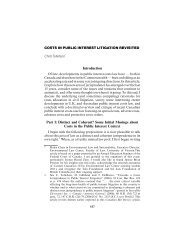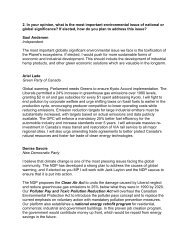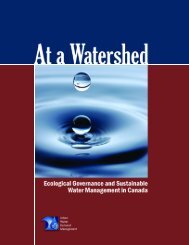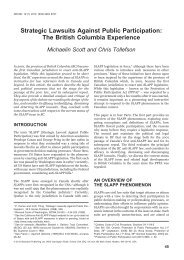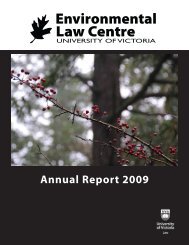Peeling back the Pavement - POLIS Water Sustainability Project
Peeling back the Pavement - POLIS Water Sustainability Project
Peeling back the Pavement - POLIS Water Sustainability Project
You also want an ePaper? Increase the reach of your titles
YUMPU automatically turns print PDFs into web optimized ePapers that Google loves.
Department of Transportation and Public Works has, since 2005, been installing<br />
RWH tanks in all new schools in regions with water quality and/or quantity issues. 34<br />
RWH decreases <strong>the</strong> pressure placed on municipal potable water infrastructure to<br />
meet all of a community’s water needs. This deferral creates savings in both energy<br />
use and greenhouse gas emissions from lower rates of pumping and treatment, 35<br />
and financial benefits in <strong>the</strong> long term from reduced infrastructure capital, operations,<br />
and maintenance costs. Researchers in Australia found that using rainwater<br />
tanks in dryer regions, such as <strong>the</strong> Lower Hunter and Central Coast, deferred drinking<br />
water infrastructure needs by 28 to 100 years, with projected savings of $78 million<br />
in Lower Hunter and $47 million in <strong>the</strong> Central Coast. The study found that wetter<br />
areas, like Sydney or Brisbane, yielded even greater water savings. 36 In a Rainwater<br />
City, uptake can be promoted by helping property owners reduce <strong>the</strong> costs associated<br />
with installing RWH systems through incentives such as rebate programs.<br />
The key to harnessing <strong>the</strong> full<br />
benefits of RWH in a Rainwater<br />
Provincial/territorial policy<br />
City is to diversify applications and endorsement and guidelines<br />
end uses across sectors so that<br />
provide needed support to<br />
rainwater storage tanks can be<br />
“early adopter” communities<br />
constantly drawn down, minimizing<br />
dependence on municipal supply. in regions that are attempting<br />
Separating drinking water supply to overcome <strong>the</strong>se regulatory<br />
from o<strong>the</strong>r water uses may facilitate<br />
barriers.<br />
this. A 2007 report from <strong>the</strong> British<br />
Royal Society of Chemistry called for a separate water supply system for drinking<br />
water pipes as an ideal system for Great Britain. 37<br />
Most major cities in Australia, driven by years of drought, require that all new<br />
construction be fitted with “purple pipe” systems (dual pipe connections that<br />
deliver recycled, non-potable water to properties) in order to meet water needs.<br />
In Canada, although rainwater can be immediately mandated for all outdoor<br />
non-potable uses (including use on city-owned properties and golf courses),<br />
builders and local governments still face a number of regulatory barriers to<br />
implementing RWH across a broad spectrum of end uses. National, provincial,<br />
and territorial building and plumbing codes lack clear differentiation between<br />
greywater, non-potable water, and rainwater. Liability concerns prevent innovative<br />
local governments from mandating purple pipes in new construction and<br />
redevelopment, and from mandating <strong>the</strong> widespread use of RWH systems inside<br />
homes and commercial buildings. Overcoming code restrictions is a crucial step to<br />
using rain as a viable source of water. Provincial/territorial policy endorsement and<br />
guidelines provide needed support to “early adopter” communities in regions that<br />
are attempting to overcome <strong>the</strong>se regulatory barriers.<br />
39



